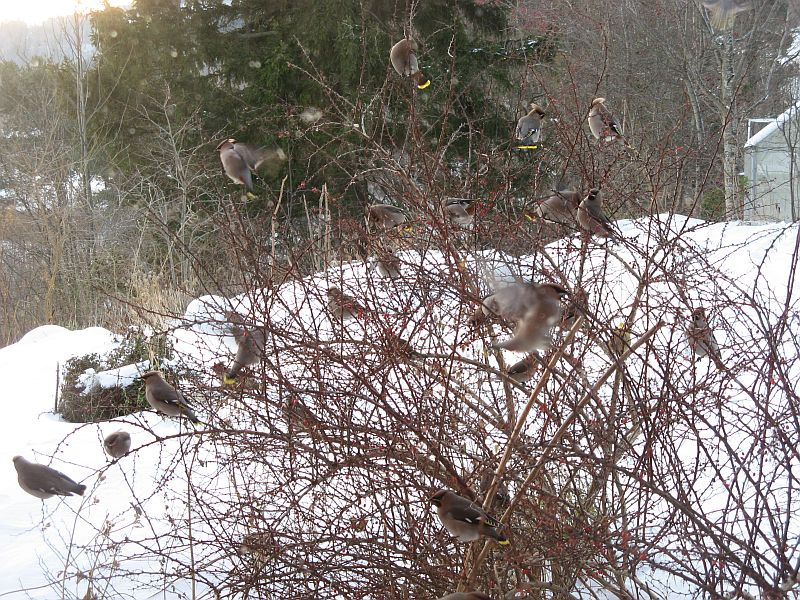Norwegian: for en norsk oversettelse av denne artikkelen (Norwegian translation), se KVANNs (Norwegian Seed Savers) Nyhetsbrev #15

There’s always been a barberry (Berberis vulgaris) in my garden, in dry soil in the root zone of my largest spruce trees. It was a large plant when we moved here in 1984 and may be wild as it’s a common plant on the other side of the bay (Malvikbukta) where it grows on shallow dry soils next to the fjord in company with sea buckthorn (Hippophae tamnoides). It is thought that this species was originally introduced in monastery gardens and later naturalised. It’s nowadays a relatively common but local plant along the Trondheimsfjord, but isn’t found much further north.

I also planted one next to the kitchen window in order to get good views of waxwings (sidensvans) and thrushes (troster) that feast on the berries in autumn and winter:


I also have a form with dark berries which I propagated by seed which I received in 1998:


Ethnobotany
There are many species of Berberis, and the closely related Mahonia, which many botanists consider to be a part of Berberis, that have been used traditionally for food around the world. In South America, several species were used including the fruit of the michay (Berberis microphylla) used by the Mapuche people of Chile and Argentina. Numerous Native American tribes used various Mahonia species both fresh and dried, for jelly and jam, tea, wine and lemonade. In Japan, several species are used for drinks and at least one species is used for a drink in China. 7 species are known to be used in Nepal, both eaten fresh, pickled, distilled into alcohol and in the case of Berberis chitria, the seeds are roasted. Fruit of Mahonia acanthifolia and Mahonia napaulensis are also eaten fresh and pickled. Another Himalayan barberry (Berberis asiatica) is said to make the best Indian raisins.
However, it is in Iran (and neighbouring Afghanistan) that barberries are really an important part of the national cuisine(s), notably zereshk polow (literally barberry rice). The eastern Iranian province of South Khorasan is the main production area of seedless Iranian barberries on (in 2014) 11,000 ha and over 9,000 tonnes of dried fruit. Cultivation goes back 200 years or so. Most authors consider that the seedless barberry, which is propagated by suckers, is Berberis vulgaris var. asperma but others that it is a form, or hybrid, Berberis integerrima ‘Bidaneh’ (bidaneh meaning seedless). Difficulty of propagation, the spiny nature of plants and the tendency to yield every other year are problems being addressed.
I like to let the birds, and in particular waxwings, take most of the barberries. However, I normally dry a few for my dried fruit mixes which I have for breakfast once the fresh apples are finished normally from April to when the first fresh fruit is available again in July (see https://www.edimentals.com/blog/?p=25352). However, this year there were very few waxwings and I dried many more than normal (over the wood stove).


 Dried barberries
Dried barberries
I’ve been inspired by Persian cuisine many times over the years, like the Persian spice golpar from the seeds of Heracleum persicum and other Heracleum species, now the spice I use more than any other (see https://www.edimentals.com/blog/?s=golpar) and Persian shallots (see https://www.edimentals.com/blog/?s=persian+shallots).
I therefore decided to try using my dried Berberis harvest in various Iranian dishes. The first was just to give a “lemony zing” to rice. I ground the dried berries and just sprinkled on the rice before serving. 


There are numerous recipes for preparing zereshk polow which you can find easily by searching on the net (including youtube videos). It’s either a layered rice dish, but the rehydrated berries are usually sprinkled on the top as a jewel-like decoration. The berries are either rehydrated by soaking in cold water for 5-10 minutes or quickly in hot water. They are also added to melted butter which plumps them up. Saffron is often an ingredient (South Khorasan is also an important production area for saffron). The Iranian spice mix, which often contains golpar (ground seeds or the flower petals of Heracleum persicum). The pilow is usually steamed and often onions, garlic and almond slices are included. I’d like to adapting this using barley or rye grains in place of the rice.
Other Ethnobotanical Uses
I’ve also recorded other uses of Berberis vulgaris in the ethnobotanical literature in Europe and West Asia:
Czech Republic: Snack food for children
Estonia: Spice for fermented cucumbers
Slovakia: Young shoots eaten raw in spring or added to sauces
Bulgaria: Fruit added to soups as a sour taste
Turkey: Used fresh or dried
Basque Country (Spain): Young shoots are eaten
Other species
In 2011 on a visit to the Dublin botanical garden, I tasted my way through a nice collection of Berberis in fruit and two of them stood out with good taste:


Nutritionally, Berberis fruits are rich in vitamin C (similar to citrus).
In some areas, it may be unadvisable to plant Berberis vulgaris as it is an alternative host for the stem rust Puccinia graminis of wheat and barley. However, modern day varieties are usually resistent.







Great article, it was lovely to see the pictures of fresh and dried berries and how the shrubs look in the garden.
Can I get seeds from you?
Thanks, sorry I don’t have any seed.